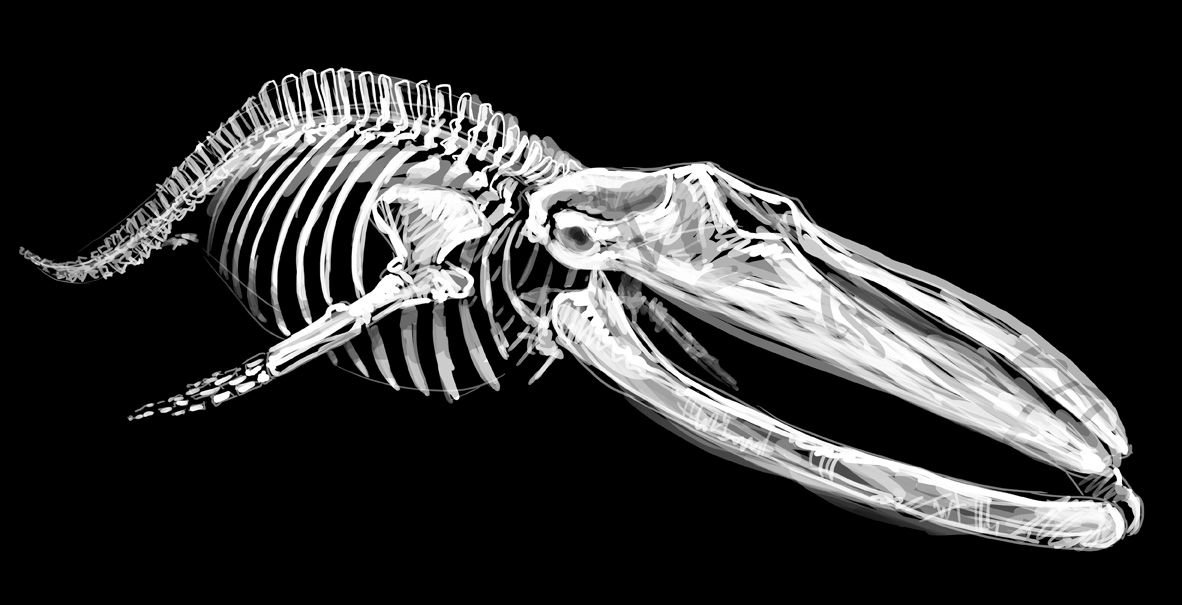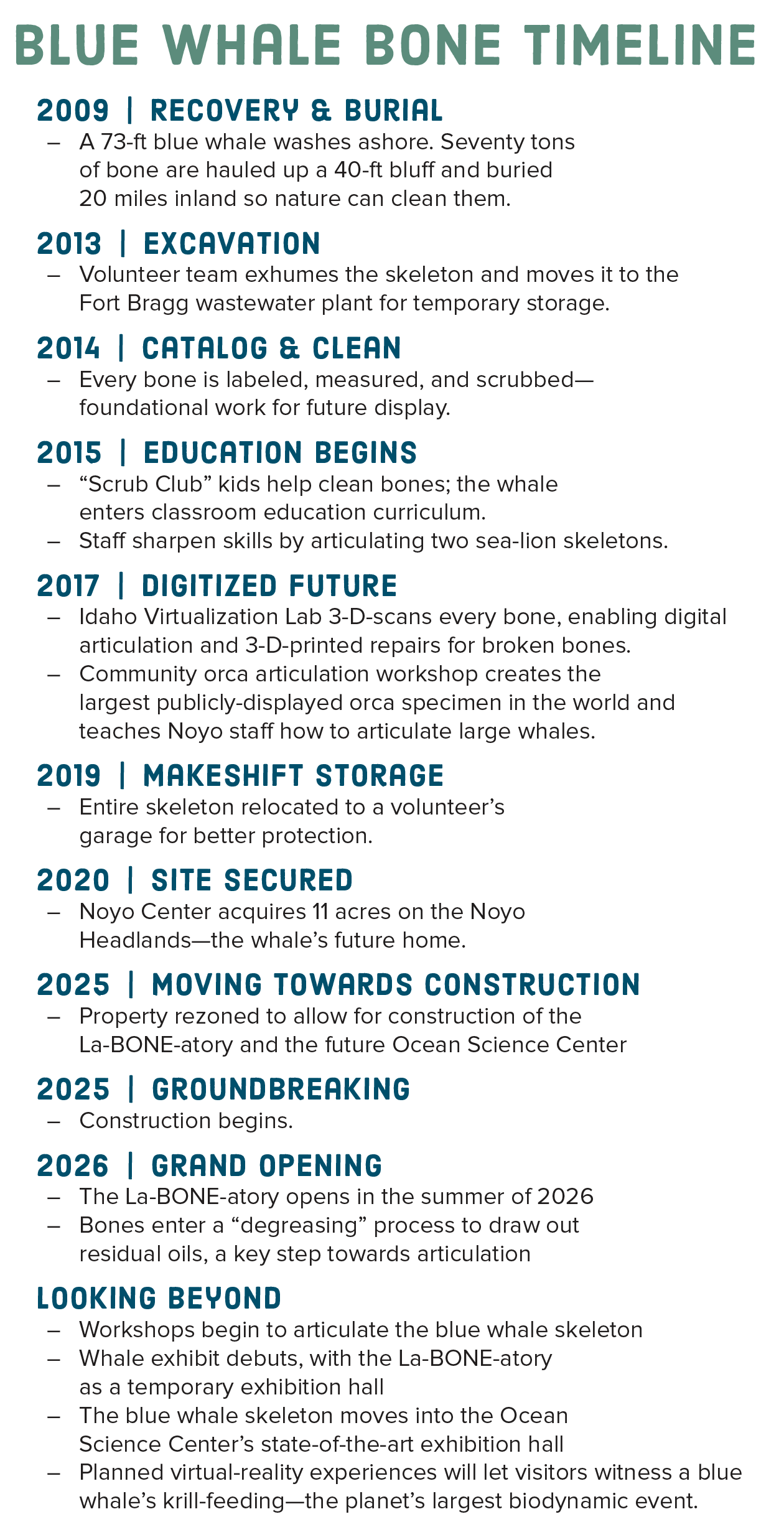
Blue Whale Project
Articulating the Noyo Center Vision, Bone by Bone
In 2009, a lethal strike from a ship’s propeller off the Mendocino coast tragically killed a 73-foot female blue whale. This ship-strike, a leading threat to these magnificent mammals, has been turned into a story of Fort Bragg’s community coming together around the vision of the Noyo Center for Marine Science.
At the Noyo Center, we believe that the desire to learn about and protect our marine environment will only come with a powerful emotional connection to the amazing underwater world.
Our dream is to turn our blue whale bones into a world-class exhibit that will represent the Noyo Center’s vision to:
Create a space in which scientists, artists and the public (of all ages) can work together, learn from each other and create multi-disciplinary opportunities
Captivate and draw young minds toward a deeper level of inquiry and connection with the marine world
Inspire our local population and attract visitors to the Mendocino coast
If you would like to learn how you can become involved in this exciting opportunity, please contact us.
The Story of Our Blue Whale
Turning tragedy into opportunity
When the devastating news that a 73-ft long female blue whale had suffered a lethal injury from a ship’s propeller off our coast in 2009 became public, the community of Fort Bragg came together. Seeing this beautiful whale washed up on shore was so moving that members of our community voiced an idea to salvage the skeleton for Fort Bragg, regardless of the fact that there would be no agency or university leading the effort. Working with NOAA, the City was able to obtain rights to acquire the skeleton for eventual public display. More than 200 people walked away from their normal lives to participate in an unprecedented community effort to haul 70-tons of bones and blubber up a 40-foot cliff and bury the whale in compost out in the forest. It was a monumental task.
Students from all over got a once-in-a-lifetime blue whale-sized anatomy lesson during the flensing process as we worked with national experts to provide as many samples for research as possible. Go to our amazing blue whales page to see the cool research we’ve been able to contribute toward so far.
Recovery
After four years of sitting in compost and sand in large pits in the forest, our amazing volunteers once again came together with the City of Fort Bragg to carefully dig out each bone. Thankfully, microbes and insects had done a good job, and most of the flesh was gone. Some bones, like the caudal vertebrae near the tail, were still encased in very strong connective tissue and had to be put back in compost to finish the job. The bones were trucked to the wastewater treatment plant in Fort Bragg where we have been cleaning and scrubbing them (what a great place for this dirty job!) Watch the story unfold in pictures below!
The skeleton is now in storage awaiting funding to begin the next stage of the restoration process: degreasing to remove the (extremely smelly!) internal oils.
As sections are brought up top, more volunteers cut away blubber and tissue
Everything is loaded up to head to the forest for burial
All of the blubber and tissue cut away are sent off to be composted
The last bone up the cliff is the skull!
Bones pile up on the cliff
Volunteers working on freeing up the skull and baleen
Things got very messy
Volunteers working on the flipper
The hyoid bone and larynx are among samples sent off for research
Heavy equipment is used to help the volunteers
As sections are brought up top, more volunteers cut away blubber and tissue
When possible, bones are carried up the cliff one by one
Larger pieces are pulled up the cliff with heavy equipment
Trying to keep the small cove open by moving out blubber by hand
The team at work "flensing"
She lodged upside down against a rock in the cove
The finger cover where the whale eventually ended up
The work was hard but fun
Mendocino High School boys get to work
Cervical vertebrae as they look after scrubbing off the dirt
More students helping out at the cleaning station
Every bone - especially the clean ones- were a triumph
Once we find the bones, garden tools are used to scrape away the sand and compost
It was very exciting to bring up a bone!
The photographs show us what to expect as we dig
4 years later, we come back to dig up the bones
Sand and compost are placed around the bones and another layer is put down
Once again, heavy equipment does a lot of the lifting
Bones are placed carefully in hole and photographed too document position
Bones in storage awaiting the next phase of restoration
Bones of the flipper
Bones of the flipper
Very last caudal vertebrae
Intervertebral disc
Lumbar vertebrae
Thoracic vertebra
Cervical vertebrae lined up
The bones look today (minus the skull which needed more time in compost)










































